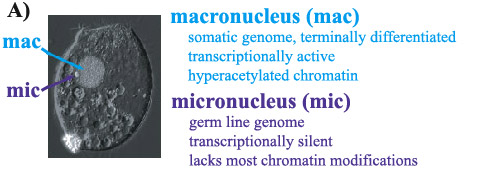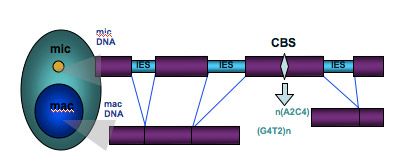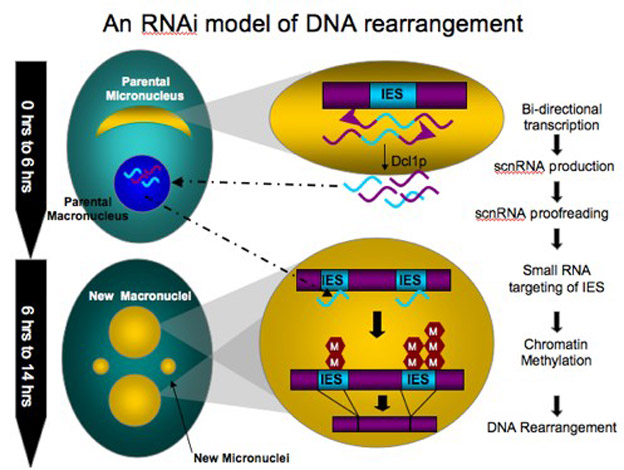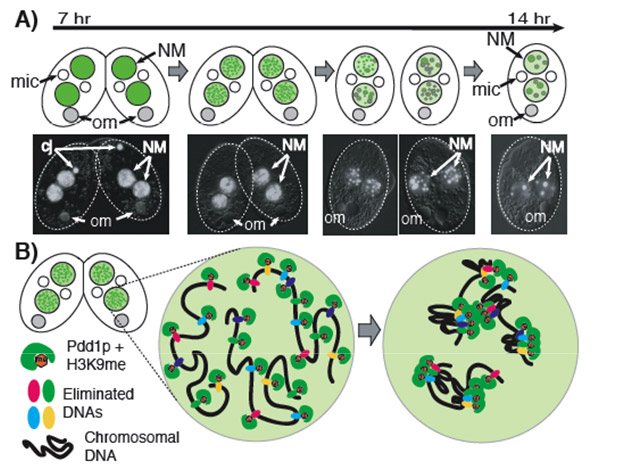
Research |
|||||
Tetrahymena genome rearrangement: unique biology reveals novel insights into epigenetic mechanisms: |
|||||
A major challenge for modern genetic research is to elucidate how cells faithfully keep some parts of the genome active and others silent. The activity state of genes is largely controlled by what are known as epigenetic mechanisms, which layer dynamic regulatory information on top of the essentially static genome. Discovery of many epigenetic mechanisms has resulted from research using model organisms, which possess biological attributes that make them particularly amenable to laboratory research. |
|||||
The ciliate Tetrahymena thermophila is a facile model organism with which to investigate how eukaryotic cells can differentially regulate genes within the genome and thereby uncover mechanisms of epigenetic regulation. Tetrahymena, like other ciliated protozoa, has a remarkable cellular organization as it contains two functionally distinct copies of its genome, which are held in two different cellular compartments, the micro- and macronucleus. The micronucleus, which harbors the germ-line genome, maintains its DNA in a silent, unabridged form to pass on to the next generation. The macronucleus, which contains the somatic genome, carries an active “Reader’s Digest” version the genome that has been highly edited. |
|||||
|
|||||
This rather unconventional biology provides a unique context within which to uncover fundamental epigenetic mechanisms that allow eukaryotic cells to establish silent and active states. |
|||||
Tetrahymena form a new somatic macronucleus and germ line micronucleus (from germ line derived genomic DNA) each time cells mate. As the new somatic genome differentiates, it undergoes extensive DNA rearrangements that result in the removal of nearly 20 Mbp of DNA from thousands of genomic loci. The DNA segments that are excised are called internal eliminated sequences or IESs. IESs can be considered “junk” DNA, as they primarily consist of the transposable elements and non-coding, repetitive DNA in the genome. We have learned that the mechanisms utilized by Tetrahymena to target this DNA for elimination are related to those that are employed commonly by diverse eukaryotes to silence specific genes or even larger regions of the genome. While most eukaryotes simply silence such genomic regions, Tetrahymena goes beyond and eliminates the DNA altogether. |
|||||
|
|||||
Small RNAs that are generated during meiosis guide the cell as to what DNA should be removed (see the model of DNA elimination below). Our research aims to understand the regulation of this massive genome reorganization and ultimately learn fundamental principles governing chromosome structure and genetic stability. |
|||||
A RNAi-guide model for DNA rearrangement: |
|||||
Homologous RNAs play a critical role in these DNA rearrangements as shown in this model. Bi-directional transcription of germline-limited sequences during meiosis is the initiating event. This transcription is the source of dsRNA that is cleaved by a Dicer-like ribonuclease encoded by DCL1 into ~28 nt small RNAs, called scan (scn)RNAs. These scnRNAs target the methylation of lysine 9 and 27 of histone H3 (H3K9me and H3K27me) on chromatin of the homologous sequence (e.g. an IES) in the developing somatic macronuclei, which signals their elimination. Disruption of the genes encoding either the Dcl1 protein (Dcl1p), an Argonaute/Piwi-related protein (TWI1) or a chromodomain-containing protein (PDD1) causes an inability of cells to generate or stabilize the scnRNAs, target H3K9 methylation, and promote subsequent DNA elimination. These data together provide strong evidence for an RNAi-like mechanism controlling IES excision. The steps prior to DNA rearrangement are mechanistically similar to the establishment of silent chromatin in the majority of eukaryotes. |
|||||
|
|||||
Research Directions:
|
|||||
The main goal of our research is to investigate how specific chromatin modifications in the developing somatic nucleus of the ciliated protozoan Tetrahymena thermophila lead to a dramatic reorganization of the genome. These efforts are aimed towards understanding both the recognition of IESs and the mechanisms that lead to their packaging into unique heterochromatin-like structures and eventually their elimination. |
|||||
|
|||||
|
How the cell recognizes thousands of dispersed IESs has been challenged by the fact that they share little common structure. We now know that small RNA copies of each IES, generated early in development, target each DNA segment for removal. To understand how these small RNAs find their homologous targets in the developing genome, we have mutated IESs to elucidate the cis-requirements for IES recognition. This effort has further supported the hypothesis that small RNAs target their corresponding DNA sequences for elimination by demonstrating that no specific segment of an IES is critical for its removal (Kowalczyk et al 2006), but that the minimal IES length necessary for its efficient recognition is correlated with the in vivo abundance of the corresponding small RNAs (C. Montero-Diez, J. Trein, J. Motl and DLC, manuscript in preparation). | ||||
|
|||||
|
One possible implication of using a RNA-guided recognition mechanism is that any DNA with a similar RNA is a potential target. We have demonstrated that the possible deleterious effects that would arise due to such inappropriate targeting can be prevented as the somatic genome of the previous generation epigenetically regulates which sequences are removed by blocking the elimination of sequences that it possesses. The timing of this regulation correlates with the decline in small RNA levels and appearance of new macronuclei (Chalker et al. 2005), which we hypothesize involves comparison of the small RNA pools with the existing somatic genome, a form of molecular “proof-reading”. To further characterize the specificity of the germ line, non-genic transcription that is postulated to be the initiating event in this remarkable genome reorganization, we are undertaking large scale sequencing of the small RNA pool to understand its biogenesis and maturation during development. In addition to uncovering the complexity of these unique small RNAs, we will discover the extent of ‘proof-reading’ that occurs during early stages of development. By “deep”-sequencing of the pool during its initial biogenesis and the pool remaining later when they direct chromatin modification, we will learn whether the parental somatic genome is a major force in selecting the pool of RNAs that promote DNA elimination. These projects focusing on IES recognition have largely been support by grants from the National Science Foundation. | ||||
|
|||||
|
One of the least understood aspects of epigenetic regulation is the influence of the three dimensional organization of the genome. Further research is essential to elucidate how epigenetic chromatin modifications contribute to nuclear organization to provide a more complete understanding of the control of processes that ensure proper maintenance of the genome. Visualization of Pdd1p localization in live cells suggests that the ~6000 IES loci organize into a countable number of nuclear foci during the 5 to 6 hour period between RNAi-directed chromatin modification and the eventual DNA elimination. This provides an excellent model to discover how cells physically organized DNA into the nucleus. By identifying and characterizing the protein machinery that accomplished this nuclear reorganization, we hope to discover the repertoire of proteins and their biochemical activities that are involved in the extensive nuclear reorganization and genome rearrangement in this ciliate. | ||||
| Given that the genome in the developing macronucleus must be rapidly transformed into the new somatic genome, we reasoned that a significant fraction of the developmentally expressed proteins that specifically localize to differentiating somatic nuclei are likely to be important for DNA rearrangements or other aspects of nuclear development. To identify such proteins, we devised a Green Fluorescent Protein (GFP)-screening strategy to detect proteins that specifically localize to developing somatic nuclei (called macronuclear anlagen) at the time that DNA rearrangement occurs (Yao et al, 2007). We discovered several new candidate proteins that localize in macronuclear | |||||
|
|||||
|
anlagen (we have called these Lia proteins). These Lia proteins are encoded by novel genes expressed at the beginning of macronuclear differentiation and have properties or recognizable domains that implicate them in chromatin or nucleic acid binding. We found four of these newly identified proteins (Lia1, 3, 4, and 5) are required for cells to complete conjugation and are necessary to organize IESs into Pdd1p-containing sub-nuclear foci where DNA rearrangement occurs. Experiments are designed to define a DNA elimination pathway in which these proteins act. To further this goal, we are undertaking proteomic analyses to identify all the proteins that act in complex with the Lia and Pdd proteins. As both the establishment of the histone H3K9 modification and the partitioning of Lia protein-containing structures near the nuclear periphery are properties shared with eukaryotic heterochromatin, we are confident these investigations will provide new insight into the epigenetic mechanisms that organize the eukaryotic genome and establish chromatin domains. This work on the LIA genes is supported by a grant from the National Institutes of Health. | ||||



